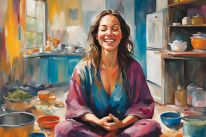
“It’s not the load that breaks you down; it’s the way you carry it.” ~Lena Horne
Friends, relatives, and the waitress who served me breakfast said I was the most relaxed bride they’d ever seen. “Most brides are ordering the bloody Mary’s right now, not the green tea,” the server remarked.
This was July 9, 2011, and I was about to marry my husband, best friend, and favorite comedian. Our wedding washed over me like a peace I had long forgotten.
Aside from finding the person I always knew I was looking for, the grace I felt that day resulted from a wedding process infused with tranquility.
Because of a hypothyroid diagnosis the year before, I had slowed down my life considerably to try and heal naturally. Graduate school completion got delayed. My health coaching business, an all-consuming love for the prior four years, was now prioritized alongside my personal life.
For the nine months leading up to our wedding, I had a social life again. I exercised consistently. I had space to breathe.
Slowing down wasn’t a winning lottery ticket. It involved examining the deep distrust of life felt in my core after being diagnosed with cancer as a teenager.
While chemotherapy and radiation cured me by the time I was 14, healing turns out to be a lifetime process.
Because I knew slowing down was temporary—“I’ll never get this chance again,” I reminded myself when old habits flared—it became easier. Rest became a foundational healing element in my life and within seven months my thyroid returned to normal. My business got incredible results for clients and I continued to easily pay my mortgage.
Life felt safe and beautiful because I was in control. The deep cancer wound I had carried around for 19 years appeared scabbed over completely. I wasn’t just the calmest bride but the calmest me I’d ever remembered.
August 22, 2011, I watched my husband leave in a taxi. He had been accepted into the Iowa Writers’ Workshop and was en route to a fiction writer’s dream. I knew since he got the acceptance phone call back in March that we’d be spending the next two academic years long-distance.
Suddenly, the Rainer Marie Rilke’s Letters to a Young Poet reading I had chosen for our wedding ceremony weren’t merely words on a page but my real life:
“Even between the closest people infinite distances exist, a marvelous living side-by-side can grow up for them, if they succeed in loving the expanse between them, which gives them the possibility of always seeing each other as a whole and before an immense sky.”
It’s poetic on paper. In real life, it’s jarring non-fiction. Things now out of my control, my anxiety story returned.
My anxiety didn’t look like panic attacks or heart palpitations. It was self-doubt that kept me constantly busy.
One more research study to analyze, one more blog to post and I’d feel safe. Eventually, I would know enough and market enough. But it turns out enough never comes if you don’t feel enough.
Doing cannot fill a being with something missing from their core. Enough is enough, not incomplete.
In an empty condo, there was tremendous space for me to be. Unlike my wedding process, this scenario wasn’t full of parties, friends, and an elegant event at the finish line.
Because I have a coaching and counseling background, I knew this wasn’t about my husband being gone. I knew it was about me having to be with myself.
Over the next couple of months, I intellectually sliced and diced thoughts and feelings only to get nowhere.
I got back into yoga. I continued with my green smoothies. Then I visited an integrated M.D.
I went in wanting to discuss the effects of screening tests I have for secondary cancers. Unexpectedly, he said he sensed I hadn’t fully integrated my cancer experience. After explaining I had seen a therapist eight years ago and felt I’d intellectualized the experience as much as possible, I surprisingly burst into tears.
To a medical doctor.
He said there are many ways to communicate with the body. He recommended an art therapist who could help me with visual imagery. This type of therapy works to communicate and heal the body at our core, or what some would call the soul.
I thanked him for the referral. Before he left the examination room, I asked how he got through medical school. He replied, “That was my near-death experience.”
What I discovered in my visual imagery work over the next seven months is the body’s intellectual technology makes the Internet look like child’s play.
I wasn’t over being sick at such a young age. I had packed my remnant pain into the trunk of a car hoping the speed of my life would help it fly away.
At autobahn speeds, the weight and awkwardness were easily forgotten. However, my tires became bare.
Visual imagery isn’t about intellectually getting over or through pain. It was learning to slow down and be with it. To accept that “it” happened.
Imagery brings buried pain to the surface in a gentle way. I found parts of my life that I wanted to deny. The parts that, at age 13, were so scary they had to disappear for me to survive the most grueling year of my life.
As I embraced those parts, the sense of peace and confidence I was looking for in all that doing surfaced on its own. The more I experienced uncomfortable feelings with a bodily intelligence, they more they dissolved into wisdom.
Caring and respecting ourselves involves honoring uncomfortable feelings as a reason to go deeper, not faster. And as wisdom dictates: to go fast you need to go slow.
I now understand the need or urge to consistently over pack my life as a warning sign. It can be a message for you too. If you are craving calm, here are some steps that can help set the stage:
1. Create an “artificial” slow down period with a beginning and end to experience how more gets done and enjoyed.
Leading up to my wedding, I received a sample taste of the joy in taking life slow, in being versus doing. Knowing this was a temporary period allowed me to enjoy this time without guilt. The pleasure and magic of experiencing myself and things seemingly happening on their own gave me the desire to keep this pace of life more consistently.
2. Stop thinking positively and allow your feelings.
Thinking I had such a great life (wonderful husband!, both fulfilling our dreams!, healthy!) made me feel guilty about feeling so down post-wedding. But these emotions were guiding me to some outstanding business that needed to be reconciled. By embracing my feelings, I was able to let the wounds of trauma not just scab, but scar—which is a lot less delicate.
3. Lose your mind and get into your body.
My pain wasn’t rational but emotionally lodged in my body memory. Regardless of how deep your pain, tapping into your body can be your prescription for an emotional release. Try starting a dialogue with your hidden emotions using visual imagery, yoga, dance, or walking meditation.
Healing isn’t a linear, rational process. As my therapist says, “In imagery, 1 + 1 equals purple.” Emotions may come up at random times.
As long as you feel more still, more complete, it’s working.
Or your symptoms may also be, like mine have been, friends and family saying they sense a new peace in you. They can’t describe it and most likely, neither can you. For it’s not what is there but rather the absence of frenzy in your core.
On August 22, 2012, my husband left after the summer break. But this time, I’m feeling centered in the transition. And I’m in no rush for these feelings to change.
Photo by ristok
About Ali Shapiro
Ali Shapiro, author, speaker and health coach, supports individuals and groups to see the emotional intelligence and wisdom in their weight-loss and wellness challenges. A regular health contributor to the NBC 10! Show, she's been featured in the Wall Street Journal, Philadelphia Magazine, and CrazySexyLife.













 Though I run this site, it is not mine. It's ours. It's not about me. It's about us. Your stories and your wisdom are just as meaningful as mine.
Though I run this site, it is not mine. It's ours. It's not about me. It's about us. Your stories and your wisdom are just as meaningful as mine. 